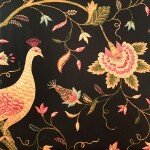Jacobean * Fleur De Lys * Paisley
Familiarizing yourself with the different types of fabric and fabric prints could take a lifetime. There is a vast array of weave types along with as many fabric prints as one can imagine.
We’ve seen these prints on many occasions when we visit the fabric store to select an upholstery for a piece of furniture or fabric for a drapery. These patterns can be found in ready-made home wares as well. These illusive yet beloved prints all have a name and I’d like to introduce them to you.
Jacobean
Jacobean refers to an embroidery style popularized during the reign of James I in England in the first quarter of the 17th Century. To give you an idea of the timeframe it was just after Shakespearean times. When thinking of those times, you begin to picture the clothing and fabrics of the time as heavily embroidered.
The Jacobean style of patterns were born out of nature – with the use of a floral and vine designs as well as animals. Some popular motifs were the Tree of Life and stylized forests.
Fleur De Lys
Translated Fleur De Lys means ‘flower of the lily’ so when one looks at the pattern they see almost a lotus type of flower – think of a lily on a pond. The Fleur De Lys is associated with perfection, light and life and has been the symbol of French royalty for centuries. The first modern Fleur De Lys, we’re told, was used on the shield of a french monarch. Later English kings used the symbol on their coats of arms to emphasize their claims to the french throne. The pattern or symbol has its roots dating back to Egyptian times.
The pattern found its way to the Americas via Sieur De La Salle who laid claim to the Mississippi valley territory in the name of the royal family from Orleans. La Salle planted a white flag with gold fleur de lys at the mouth of the mighty river. While the territory did change hands until becoming the Louisiana purchase, the flag still waves today as a symbol of New Orleans, Louisiana.
Today, French Quarter Market design style is its own category of design. One can find all things imprinted or styled with the infamous, royal symbol.
Paisley
One of my personal favorites, paisley. Just the name conjures visions of a swirling tear drop in a myriad of colors. While the shape is of Iranian origin, the name derives itself from the town of Paisley in Western Scotland where textile paisley designs were produced.
Some believe the paisley design is a combination of a loral spray with a cypress tree and some see it as a symbol of life. Imported in the first half of the 17th century, paisley and other Indian influenced prints became popular. The East India Company who was one of the first companies to export the patterned fabric were unable to meet the initial demand.
These demands have not lessened over the years as paisley maintains itself as a modern, desired pattern to this day.







